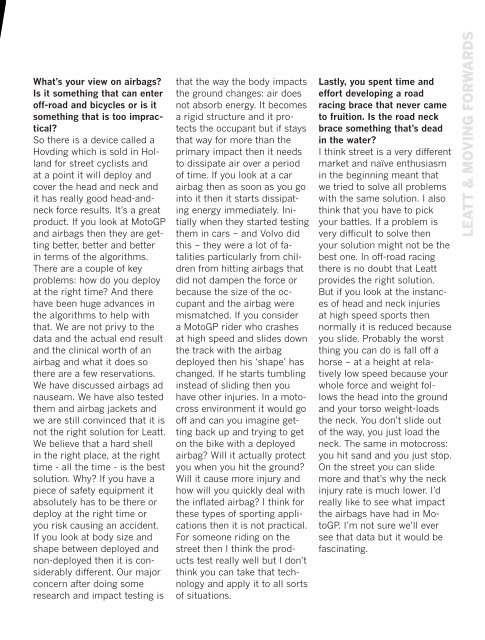You also want an ePaper? Increase the reach of your titles
YUMPU automatically turns print PDFs into web optimized ePapers that Google loves.
What’s your view on airbags?<br />
Is it something that can enter<br />
off-road and bicycles or is it<br />
something that is too impractical?<br />
So there is a device called a<br />
Hovding which is sold in Holland<br />
for street cyclists and<br />
at a point it will deploy and<br />
cover the head and neck and<br />
it has really good head-andneck<br />
force results. It’s a great<br />
product. If you look at MotoGP<br />
and airbags then they are getting<br />
better, better and better<br />
in terms of the algorithms.<br />
There are a couple of key<br />
problems: how do you deploy<br />
at the right time? And there<br />
have been huge advances in<br />
the algorithms to help with<br />
that. We are not privy to the<br />
data and the actual end result<br />
and the clinical worth of an<br />
airbag and what it does so<br />
there are a few reservations.<br />
We have discussed airbags ad<br />
nauseam. We have also tested<br />
them and airbag jackets and<br />
we are still convinced that it is<br />
not the right solution for Leatt.<br />
We believe that a hard shell<br />
in the right place, at the right<br />
time - all the time - is the best<br />
solution. Why? If you have a<br />
piece of safety equipment it<br />
absolutely has to be there or<br />
deploy at the right time or<br />
you risk causing an accident.<br />
If you look at body size and<br />
shape between deployed and<br />
non-deployed then it is considerably<br />
different. Our major<br />
concern after doing some<br />
research and impact testing is<br />
that the way the body impacts<br />
the ground changes: air does<br />
not absorb energy. It becomes<br />
a rigid structure and it protects<br />
the occupant but if stays<br />
that way for more than the<br />
primary impact then it needs<br />
to dissipate air over a period<br />
of time. If you look at a car<br />
airbag then as soon as you go<br />
into it then it starts dissipating<br />
energy immediately. Initially<br />
when they started testing<br />
them in cars – and Volvo did<br />
this – they were a lot of fatalities<br />
particularly from children<br />
from hitting airbags that<br />
did not dampen the force or<br />
because the size of the occupant<br />
and the airbag were<br />
mismatched. If you consider<br />
a MotoGP rider who crashes<br />
at high speed and slides down<br />
the track with the airbag<br />
deployed then his ‘shape’ has<br />
changed. If he starts tumbling<br />
instead of sliding then you<br />
have other injuries. In a motocross<br />
environment it would go<br />
off and can you imagine getting<br />
back up and trying to get<br />
on the bike with a deployed<br />
airbag? Will it actually protect<br />
you when you hit the ground?<br />
Will it cause more injury and<br />
how will you quickly deal with<br />
the inflated airbag? I think for<br />
these types of sporting applications<br />
then it is not practical.<br />
For someone riding on the<br />
street then I think the products<br />
test really well but I don’t<br />
think you can take that technology<br />
and apply it to all sorts<br />
of situations.<br />
Lastly, you spent time and<br />
effort developing a road<br />
racing brace that never came<br />
to fruition. Is the road neck<br />
brace something that’s dead<br />
in the water?<br />
I think street is a very different<br />
market and naïve enthusiasm<br />
in the beginning meant that<br />
we tried to solve all problems<br />
with the same solution. I also<br />
think that you have to pick<br />
your battles. If a problem is<br />
very difficult to solve then<br />
your solution might not be the<br />
best one. In off-road racing<br />
there is no doubt that Leatt<br />
provides the right solution.<br />
But if you look at the instances<br />
of head and neck injuries<br />
at high speed sports then<br />
normally it is reduced because<br />
you slide. Probably the worst<br />
thing you can do is fall off a<br />
horse – at a height at relatively<br />
low speed because your<br />
whole force and weight follows<br />
the head into the ground<br />
and your torso weight-loads<br />
the neck. You don’t slide out<br />
of the way, you just load the<br />
neck. The same in motocross:<br />
you hit sand and you just stop.<br />
<strong>On</strong> the street you can slide<br />
more and that’s why the neck<br />
injury rate is much lower. I’d<br />
really like to see what impact<br />
the airbags have had in MotoGP.<br />
I’m not sure we’ll ever<br />
see that data but it would be<br />
fascinating.<br />
LEATT & MOVING FORWARDS

















